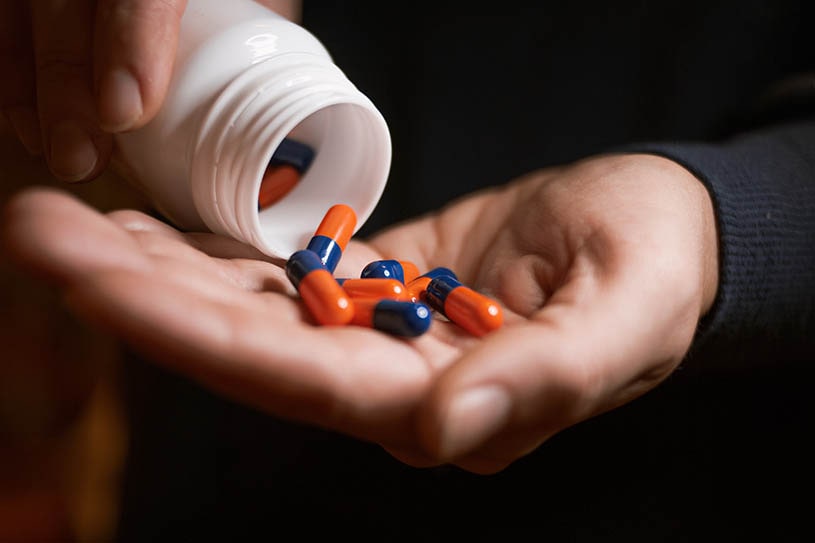
Lunesta (Generic name: Eszopiclone) is a medication commonly used in the treatment of sleep disorders (Insomnia). Currently, it is one of the most popular sleep aids in America and is in the same category of sedatives as Ambien and Sonata. Everyone experiences some form of insomnia at some point in their lives. While the occasional night of little to no sleep is usually nothing to be concerned about, chronic lack of sleep can be detrimental to health.
Table Of Contents:
It can have negative impacts on one’s ability to function at home as well as at work. Eszopiclone is often prescribed when insomnia starts hindering a person’s daily functioning. It is a prescription medication that is used to help patients fall asleep faster and stay asleep longer. It also touts that it can improve the quality of sleep thus helping users achieve a sound sleep without waking up frequently during the night. While it is designed with safety in mind, long-term use or misuse may result in discomforting side effects or can lead to abuse and addiction.
What Is Lunesta?
Eszopiclone (Lunesta) is a “sedatives/hypnotics” class of medication usually prescribed to treat sleeping disorders. It is a nonbenzodiazepine hypnotic drug that affects various chemicals in the brain to help people with insomnia to regulate their sleep and is believed to interact with GABA receptors.
Lunesta is beneficial for the short-term treatment of insomnia, and its benefits can typically be noticed within one week from the beginning of the treatment. It has an effective half-life of six hours, and it will be out of the system after almost 24-48 hours of ingestion. Eszopiclone was approved for medical use in the USA in 2004 and is currently available as a generic medicine. Lunesta is a Schedule IV Controlled Substance(C-IV) in the USA, meaning that the potential for abuse and dependency is not very high, though still possible.
More About Depressants:
What Is Lunesta Used For?
Eszopiclone is indicated in the treatment of transient and chronic insomnia for sleep onset and sleep maintenance in patients older than 18 years of age. It makes people sleep faster, longer and decreases the frequency of midnight awakenings.
Some Off-The-Label Uses of Eszopiclone Include:
- Lunesta for Anxiety
- PTSD
- Depression
- Schizophrenia
Even though Lunesta has demonstrated efficacy in such diseases as posttraumatic stress disorder and schizophrenia, overall, it is best to use Lunesta for sleep as it is most efficient in its use as a sleeping aid, and side effects can be different for each individual.
Lunesta Generic And Brand Names
Eszopiclone is the generic name as well as the main active component of this medicine.
Lunesta (Eszopiclone) Is Also Available For Consumption Under The Following Brand Names:
- Eszop
- Bexomer
- Zopimin S
- Zopipure
Use of alternate brand/trade names of this medicine is absolutely fine as long as the generic strength and dosage are the same. However, it’s best to consume the brand as prescribed by the doctor.
Lunesta Dosage Forms and Strength
Eszopiclone (Lunesta) is a cyclopyrrolone class of sedative/hypnotic medicine. It is available in 1 mg, 2 mg, and 3 mg strengths for oral administration.
- 1 mg tablets: These tablets are round-shaped, light blue colored, film-coated, and identified with debossed markings of S190 on one side.
- 2 mg tablets: These are round-shaped, white-colored, film-coated, and identified with debossed markings of S191 on one side.
- 3 mg tablets: These are round-shaped, dark blue colored, film-coated, and identified with debossed markings of S193 on one side.
As Eszopiclone is a prescription-only medication, a physician should always be consulted to take the lowest dose effective for the patient. US FDA has recommended that the initial dose of this drug is 1 mg, and should be taken immediately before bedtime, with at least 7-8 hours remaining before the planned time of awakening. The physician may increase the dose, if clinically indicated, to a maximum of 3 mg. Lunesta dosage should not exceed 2 mg in geriatric or debilitated patients. Patients with severe hepatic impairment, or taking potent CYP3A4 inhibitor drugs should not take more than 2 mg of this drug. Patients should not take it with or immediately after a meal as it can impair absorption and delay the onset of action.
Is Lunesta Addictive?
Addiction is a primary, chronic neurobiological disorder that is characterized by continuous and compulsive engagement in a behavior despite adverse consequences. It can be influenced by various genetic, psychosocial, and environmental factors. Impaired control over drug use, cravings, and irresistible drug use despite the knowledge of its harm are the features commonly associated with drug addiction. Eszopiclone is a Schedule IV Controlled Substance under the Controlled Substance Act which means it has low abuse potential, but even that abuse may lead to physical and/or psychological dependence. The risk of abuse and dependence increases with the dose and duration of treatment and concomitant use of other psychoactive drugs. Patients who have a history of alcoholism, drug abuse, or other psychiatric disorders are at a greater risk of abuse and dependence.

Lunesta Abuse Statistics
As it is a CNS depressant, it can impair daytime functioning when taken in higher doses. According to the US FDA, a study of abuse liability showed that eszopiclone at doses of 6 and 12 mg produced Euphoria, Amnesia, and Hallucinations. This study was conducted on patients with a known history of benzodiazepine abuse. These effects were similar to the effects associated with Diazepam use. In this study, when the dose was twice or greater than the maximum recommended dose, a dose-related increase in reports of amnesia and hallucinations was observed for both Eszopiclone Lunesta and Diazepam.
Lunesta Addiction Risk Groups: Who Is At Higher Risk of Abuse
Sleep aid abuse is a common occurrence among those who are also taking other drugs and/or alcohol. While drug addiction and abuse is a chronic, neurobiological problem that can affect even those who would least expect it, some individuals are at more risk than others.
These Include:
- Professionals –Those in professional fields are faced with job-related stress, anxiety, and insomnia every day. These individuals are more likely to turn to drugs and alcohol in the search of an escape to reality. In addition, these individuals are also found to use Lunesta, in doses higher than recommended, for supposed recreational purposes.
- Veterans – Individuals with Post Traumatic Stress Disorders (PTSD) like many veterans deal with PTSD-related insomnia. These individuals often benefit from the sleep-inducing effects of Lunesta. However, they might be tempted to use a higher dose and amount in an attempt to get a better result thus increasing the risk of abusing prescription medications and other drugs.
- Young adults – According to the National Survey on Drug and Health in 2016, Teens, college students, and young professionals may try drugs, including sleep aids, to cope with work or school/peer pressure, or because they are easily accessible when parents or others in the household have been prescribed these medications. Consumption of Eszopiclone when not indicated and without any consultation with the doctor may risk the potential of abuse and addiction.
- Sleep disorders patients – Since Lunesta is commonly prescribed as a treatment for insomnia, those with certain sleep disorders may be more likely to abuse Lunesta. This could increase the chances of developing a full-blown addiction. For instance, if someone is taking Lunesta and becomes tolerant to it, more medication will be needed to achieve the desired results. Doing this over time increases one’s dependency and leads to subsequent addiction.
- Mental illness patients– Those with certain mental disorders may also have a high rate of addiction. Anxiety and other mental disorders patients usually suffer from various forms of insomnia. They usually benefit from the relaxing and calming effects of sleep medications. However, this beneficial effect may turn into a harmful one if these individuals overdose on this medicine. Patients with anxiety, depression, and panic disorders are at a particularly high risk of abusing sleep aids.
- Drug Addicts – Patients who are already addicted to another drug or substance are more likely to become addicted to Lunesta. This is primarily because Lunesta is often combined with alcohol and other drugs to enhance or increase their effects. Those who have a preexisting drug addiction or history of abuse should discuss their personal drug history with their doctors before trying Lunesta.
Apart from the above-mentioned group of individuals, other people may also be at a higher risk of abusing Eszopiclone, although statistics on other groups are not available yet.
Physical Signs and Symptoms of Lunesta Addiction and Abuse
Individuals who engage in compulsive and continuous use of sedative/hypnotic drugs despite adversities may become dependent (physical dependence) on these substances which may lead to addiction. These changes become more pronounced as a person becomes more addicted to the drug.
Some Physical Signs And Symptoms Associated With Lunesta Addiction Are:
- A general decline in functioning
- Drowsy, tired, and foggy appearance
- Tolerance to the drug
- Daily consumption of the drug over a longer period
- “Doctor hopping” to avoid questioning and get an additional prescription about drug use
- Poor personal hygiene
These symptoms associated with Lunesta abuse may also be related to sleep deprivation, the primary reason for which these are prescribed. A physician or a close relative must be aware of the above-mentioned signs and symptoms to detect early prescription misuse.
Psychological/Behavioral Signs and Symptoms of Lunesta Addiction and Abuse
Physical changes are usually accompanied by psychological/behavioral changes of Lunesta addiction and abuse. Listed below are some potential signs and symptoms when individual abuse this drug :
- Reduced inhibition (such as aggressiveness and extroversion that seem out of character)
- Bizarre behavior, agitation, hallucinations, and depersonalization
- Amnesia and other neuropsychiatric symptoms
- In primarily depressed patients, worsening of depression, including suicidal thoughts and actions (including completed suicides)
- “Sleep-driving” (i.e., driving while not fully awake after ingestion of a sedative-hypnotic, with no memory of the event)
Immediate medical attention should be sought on the emergence of the above-mentioned physical/psychological signs and symptoms for prompt diagnosis and treatment. Any delay while recognizing these red flag signs of addiction may lead to a potential overdose which can be life-threatening.

Dangers of Lunesta Abuse and Addiction
Lunesta when consumed as prescribed by a licensed doctor can significantly improve the well-being of patients suffering from Insomnia. On the contrary, compulsive use beyond the recommended dose and duration can lead to addiction. According to the US FDA, the dangers of Lunesta abuse and addiction involve impairment of consciousness ranging from somnolence to coma. Rare individual instances of fatal outcomes following overdose with Lunesta have been reported, most often associated with overdose with other CNS-depressant agents.
Lunesta Withdrawals
Rapid decrease in doses or abrupt discontinuation of its use can cause uncomfortable withdrawal symptoms that might make a patient less confident in the ability to detox and get clean. The reduced compliance to detox therapy might eventually hamper the recovery process. Usually, withdrawal is a definite sign of addiction. People experiencing Lunesta withdrawals, have signs and symptoms similar to those associated with other CNS depressants withdrawal, including:
- Weakness
- Anxiety and nervousness
- Fatigue
- Dizziness
- Feeling faint
- Feeling sick
- Unable to control your movements
- Loss of memory
- Heart pounding (palpitations)
- Feeling full-headed or headache
Health experts recommend a gradual tapering of the dosage to decrease these withdrawal symptoms and promote a successful recovery. Facilities such as inpatient rehabs, outpatient centers, and individual programs might be very beneficial for careful monitoring while stopping the use of this drug.
Lunesta Addiction Treatment Options
The first step in finding help, though, is recognizing and admitting a problem exists. Those who don’t believe they are addicts are less likely to follow through with a rehabilitation program. which can prove to be a roadblock to recovery.
Once the person’s addiction to Lunesta and/or other drugs has been established, a professionally trained drug and alcohol abuse counselor should be contacted. A professional drug counselor can effectively plan the most appropriate intervention for the patient. The first step towards a clean life is detox. Tapering off is recommended instead of going cold turkey as rebound symptoms won’t kick too hard.
Thus, There Are a Variety of Options Available:
- Support groups and 12-step programs – These groups are usually attended by other addicts, and a team leader or professional counselor to lead the discussions. Attendees have the opportunity to get to know others who are in various stages of their journeys to sobriety and get moral support along the way. This is a great encouragement to many addicts for a successful recovery from substance abuse and addiction.
- Outpatient counseling – Seeing a counselor one on one is a good idea for anyone abusing drugs or medications. A personal counselor or medical personnel can help get to the bottom of why the drug abuse is occurring, and point out potential pitfalls and stumbling blocks. An outpatient rehab center can be a good avenue to discuss these and other health-related matters.
- Inpatient Rehabilitation – Inpatient facilities are often the safest and most effective way to overcome drug addiction. During the process of detoxifying and getting off the drugs, withdrawal symptoms can present potentially deadly side effects. Trained medical personnel will be there to oversee this process in an inpatient facility. Some of these facilities also have sleep centers to get to the bottom of underlying sleep disorders which further aids in recovery.
There are numerous treatment options available for those who have a drug abuse or addiction problem. While there are few facilities for those who are addicted to Lunesta specifically, one can find various centers to seek help for all kinds of drug issues and recovery, as well as get information about the possible alternatives to Lunesta.
Hope Without Commitment
Find the best treatment options. Call our free and confidential helpline
Most private insurances accepted
Find Drug Rehabilitation Centers Near You Anywhere In the US
Addiction Resource team has compiled an extensive list of the top drug rehabilitation facilities around the country. Use our locator tool to find the best centers near you.
Page Sources
- Melton, S. T., Wood, J. M., & Kirkwood, C. K. (2005). Eszopiclone for insomnia. The Annals of pharmacotherapy, 39(10), 1659–1666. https://doi.org/10.1345/aph.1G179
- Pollack, M. H., Hoge, E. A., Worthington, J. J., Moshier, S. J., Wechsler, R. S., Brandes, M., & Simon, N. M. (2011). Eszopiclone for the treatment of posttraumatic stress disorder and associated insomnia: a randomized, double-blind, placebo-controlled trial. The Journal of clinical psychiatry, 72(7), 892–897. https://doi.org/10.4088/JCP.09m05607gry
- Tek, C., Palmese, L. B., Krystal, A. D., Srihari, V. H., DeGeorge, P. C., Reutenauer, E. L., & Guloksuz, S. (2014). The impact of eszopiclone on sleep and cognition in patients with schizophrenia and insomnia: a double-blind, randomized, placebo-controlled trial. Schizophrenia Research, 160(1-3), 180–185. https://doi.org/10.1016/j.schres.2014.10.002
- Jaffe, J. H., Bloor, R., Crome, I., Carr, M., Alam, F., Simmons, A., & Meyer, R. E. (2004). A postmarketing study of relative abuse liability of hypnotic sedative drugs. Addiction (Abingdon, England), 99(2), 165–173. https://doi.org/10.1111/j.1360-0443.2003.00631.x
- Schifano, F., Chiappini, S., Corkery, J. M., & Guirguis, A. (2019). An Insight into Z-Drug Abuse and Dependence: An Examination of Reports to the European Medicines Agency Database of Suspected Adverse Drug Reactions. The international journal of Neuropsychopharmacology, 22(4), 270–277. https://doi.org/10.1093/ijnp/pyz007
- Inoue, Y., Takaesu, Y., & Koebis, M. (2021). Prevalence of and factors associated with acute withdrawal symptoms after 24 weeks of eszopiclone treatment in patients with chronic insomnia: a prospective, interventional study. BMC psychiatry, 21(1), 193. https://doi.org/10.1186/s12888-021-03196-0


 Reviewed by:
Reviewed by:  Written by:
Written by: 


 FindTreatment.gov
FindTreatment.gov